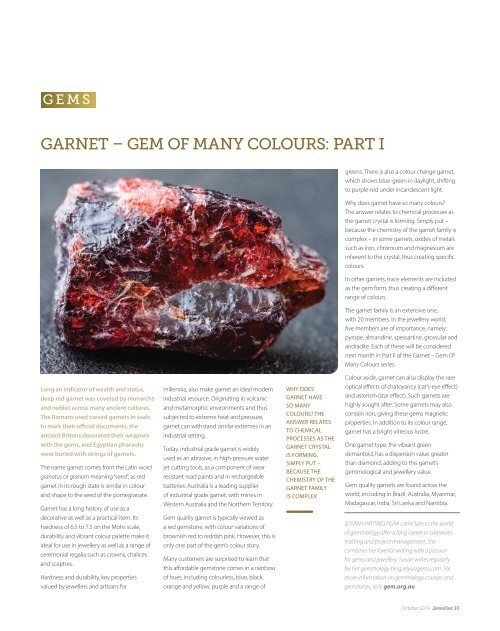Jeweller - October 2019
Create successful ePaper yourself
Turn your PDF publications into a flip-book with our unique Google optimized e-Paper software.
GEMS<br />
GARNET – GEM OF MANY COLOURS: PART I<br />
greens. There is also a colour change garnet,<br />
which shows blue-green in daylight, shifting<br />
to purple-red under incandescent light.<br />
Why does garnet have so many colours?<br />
The answer relates to chemical processes as<br />
the garnet crystal is forming. Simply put –<br />
because the chemistry of the garnet family is<br />
complex – in some garnets, oxides of metals<br />
such as iron, chromium and magnesium are<br />
inherent to the crystal, thus creating specific<br />
colours.<br />
In other garnets, trace elements are included<br />
as the gem form, thus creating a different<br />
range of colours.<br />
FIGURE 1. CORROSION TUBES<br />
FIGURE 2. LAMELLAR TWINNING<br />
The garnet family is an extensive one,<br />
with 20 members. In the jewellery world,<br />
five members are of importance, namely:<br />
pyrope, almandine, spessartine, grossular and<br />
andradite. Each of these will be considered<br />
next month in Part II of the Garnet – Gem Of<br />
Many Colours series.<br />
Long an indicator of wealth and status,<br />
deep red garnet was coveted by monarchs<br />
and nobles across many ancient cultures.<br />
The Romans used carved garnets in seals<br />
to mark their official documents, the<br />
ancient Britons decorated their weapons<br />
with the gems, and Egyptian pharaohs<br />
were buried with strings of garnets.<br />
The name garnet comes from the Latin word<br />
granatus or granum meaning “seed”, as red<br />
garnet in its rough state is similar in colour<br />
and shape to the seed of the pomegranate.<br />
Garnet has a long history of use as a<br />
decorative as well as a practical item. Its<br />
hardness of 6.5 to 7.5 on the Mohs scale,<br />
durability and vibrant colour palette make it<br />
ideal for use in jewellery as well as a range of<br />
ceremonial regalia such as crowns, chalices<br />
and sceptres.<br />
Hardness and durability, key properties<br />
valued by jewellers and artisans for<br />
millennia, also make garnet an ideal modern<br />
industrial resource. Originating in volcanic<br />
and metamorphic environments and thus<br />
subjected to extreme heat and pressure,<br />
garnet can withstand similar extremes in an<br />
industrial setting.<br />
Today, industrial grade garnet is widely<br />
used as an abrasive, in high-pressure water<br />
jet cutting tools, as a component of wear<br />
resistant road paints and in rechargeable<br />
batteries. Australia is a leading supplier<br />
of industrial grade garnet, with mines in<br />
Western Australia and the Northern Territory.<br />
Gem quality garnet is typically viewed as<br />
a red gemstone, with colour variations of<br />
brownish red to reddish pink. However, this is<br />
only one part of the gem’s colour story.<br />
Many customers are surprised to learn that<br />
this affordable gemstone comes in a rainbow<br />
of hues, including colourless, blue, black,<br />
orange and yellow, purple and a range of<br />
WHY DOES<br />
GARNET HAVE<br />
SO MANY<br />
COLOURS? THE<br />
ANSWER RELATES<br />
TO CHEMICAL<br />
PROCESSES AS THE<br />
GARNET CRYSTAL<br />
IS FORMING.<br />
SIMPLY PUT –<br />
BECAUSE THE<br />
CHEMISTRY OF THE<br />
GARNET FAMILY<br />
IS COMPLEX<br />
Colour aside, garnet can also display the rare<br />
optical effects of chatoyancy (cat’s-eye effect)<br />
and asterism (star effect). Such garnets are<br />
highly sought after. Some garnets may also<br />
contain iron, giving these gems magnetic<br />
properties. In addition to its colour range,<br />
garnet has a bright vitreous lustre.<br />
One garnet type, the vibrant green<br />
demantoid, has a dispersion value greater<br />
than diamond, adding to this garnet’s<br />
gemmological and jewellery value.<br />
Gem quality garnets are found across the<br />
world, including in Brazil, Australia, Myanmar,<br />
Madagascar, India, Sri Lanka and Namibia.<br />
SUSAN HARTWIG FGAA came late to the world<br />
of gemmology after a long career in corporate<br />
training and project management. She<br />
combines her love for writing with a passion<br />
for gems and jewellery. Susan writes regularly<br />
for her gemmology blog ellysiagems.com. For<br />
more information on gemmology courses and<br />
gemstones, visit: gem.org.au<br />
<strong>October</strong> <strong>2019</strong> <strong>Jeweller</strong> 37


















